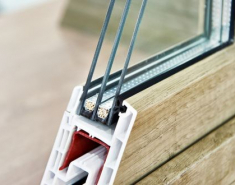Building Envelope Condition Assessments
Whether it’s new or old, large or small, commercial or residential, all buildings benefit from Building Envelope Condition Assessments. A practice that has been around since buildings themselves were erected, the earliest form of condition assessments involved inspecting the building’s exterior for signs of weakness or impending danger. Leaks, cracks, and trouble spots would be monitored, fixed or replaced in an effort to maximize the structure’s useful life, and increase occupant comfort and safety.
Today, the goal is largely the same, but the scope of our understanding and the depth of knowledge gained from these periodic assessments is far superior thanks to technology.
“Simply put,” says Jelena Bojanic, Project Engineer with RJC Engineers, “any structure with an enclosure protecting the occupied space from the exterior elements requires some level of periodic assessment to understand how it is performing and what maintenance should be considered to uphold the envelope integrity and the comfort of the occupants.”
Far from rudimentary, today’s on-site condition assessments involve a holistic and comprehensive analysis conducted by a qualified inspector using advanced tools and measures to gain a complete read on the exterior building systems.
“An assessment can provide information on how the envelope is performing, as well as recommendations and budgeting for maintenance programs, life cycle renewal projections as well as an assessment of potential unsafe conditions,” Bojanic says.
Typically the first step is to review the building’s structural and architectural drawings, and any records related to its performance history — including past repairs, modifications and maintenance. Armed with this knowledge, the inspector then conducts the on-site portion of the assessment. Afterwards, a report outlining observations, conclusions and recommendations is developed and provided to the owner.
“The report presents our opinions with respect to potential unsafe conditions, remaining useful service life of the façade assemblies, options of future maintenance and renewal along with expected timing for service life replacement,” Bojanic says. “Opportunities to enhance occupant comfort, reduce energy consumption or modernize the building facades can also be explored.”
Signs of deficiencies
Most of the qualitative and quantitative information comes from the on-site portion of the assessment, which typically begins with an interior review to check for signs of moisture and air leakage. Signs may include: staining on interior finishes; damages to flooring and ceiling; wet areas on windows; or damp, musty smells.
During the concluding exterior façade review, inspectors are taking note of the building’s water and air tightness, the condition of its cladding, window systems and roof assemblies, with the intent being to identify if potential unsafe conditions exist, and to quantify deterioration or deficiencies that might impact the building’s useful remaining service life.
“The level and frequency of these assessments will depend on the age and performance history of the building,” says Bojanic, noting that in some cases it may be required by the local specifying authority.
Some of the tools and techniques employed by the inspector include:
Exploratory dismantling of cladding components;
Temperature, moisture, and humidity readings;
Thermographic scanning to identify areas of heat loss that may be related to air leakage, thermal bridging or other envelope deficiencies;
Air leakage testing of various assemblies with a hand-held smoke pencil, or similar methods;
Water penetration testing using a spray nozzle/rack;
Frost point testing on sealed insulating glass units to assess remaining service life before seal failure (fogging);
Sampling of materials for laboratory testing;
Sounding of the exterior façade surface with a hammer if material delamination is suspected on a façade.
It sounds comprehensive indeed, but—as Bojanic warns—not all building assessments were created equal, and getting what you pay for means hiring the right team. Building owners should be diligent about only enlisting the services of qualified, reputable, professional engineers.
“An example of a bad assessment would be one that does not provide the owner with useful information regarding the current performance of the building envelope, and does not provide the owner with recommendations for maintenance and repairs,” she says.
Source: https://bit.ly/2Zf8eIO









